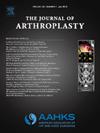股骨头骨坏死行原发性关节置换术后,髋关节置换术的改变可降低脱位风险。
IF 3.8
2区 医学
Q1 ORTHOPEDICS
引用次数: 0
摘要
背景:随着时间的推移,髋关节置换术已经有了很大的发展。这项全国性的多中心随访队列研究针对股骨头坏死行原发性髋关节置换术,旨在解决以下问题:人口统计学和手术变量以及随访结果(脱位和需要再手术)是否随时间而改变?方法:对7494例人工髋关节置换术患者进行分析,按手术日期分为3个9年期:第1期(1996 - 2004年,1403髋),第2期(2005 - 2013年,2631髋),第3期(2014 - 2022年,3460髋)。结果:人口统计学特征随时间逐渐改变,手术变量变化明显。后路入路的使用减少,更大的假头变得更常见。总体脱位率为4.1%(307髋),因手术类型而异:全髋关节置换术(tha)为4.7%,双极半髋关节置换术为1.1%,表面置换为0%(卡方检验;P < 0.001)。对6207例全关节置换术患者(6026例tha和181例全关节表面置换术)进行脱位相关因素分析,平均随访7.1年(范围0.5 - 27年)。脱位率为4.7%,第一、第二和第三期脱位率分别为10.5、5.4和2.3%(卡方检验;P < 0.001)。多因素logistic回归证实脱位风险随时间降低;与第二期相比,第一期和第三期的优势比分别为1.48 (P = 0.015)和0.58 (P = 0.001)。再手术的风险在时间上没有明显的变化。结论:随着时间的转移,人口统计学特征逐渐演变,手术技术也发生了显著变化。后路入路使用的减少和更大假体头的采用可能有助于观察到脱位风险的降低。然而,再手术的风险在不同时期保持不变。本文章由计算机程序翻译,如有差异,请以英文原文为准。
Changes in Hip Arthroplasty Practice Decreased Dislocation Risk After Primary Arthroplasties Performed for Nontraumatic Osteonecrosis of the Femoral Head
Background
Hip arthroplasty practices have evolved considerably over time. This nationwide multicenter follow-up cohort study of primary hip arthroplasties performed for nontraumatic osteonecrosis of the femoral head aimed to address the following question: Have demographic and operative variables, as well as follow-up outcomes (dislocation and need for reoperation), changed over time?
Methods
A total of 7,494 hip arthroplasties were analyzed, categorized into three 9-year periods based on the date of operation: the first (1996 to 2004, 1,403 hips), the second (2005 to 2013, 2,631 hips), and the third (2014 to 2022, 3,460 hips) periods.
Results
Demographic characteristics changed gradually over time, while operative variables shifted significantly. The use of the posterior approach declined, and larger prosthetic heads became more common. The overall dislocation rate was 4.1% (307 hips) and varied by surgery type: 4.7% in total hip arthroplasties, 1.1% in bipolar hemiarthroplasties, and 0% in resurfacings (Chi-square test; P < 0.001). Factors associated with dislocation were analyzed in 6,207 total arthroplasties (6,026 total hip arthroplasties and 181 total resurfacings) with a mean follow-up of 7.1 years (range, 0.5 to 27). The dislocation rate was 4.7%, with rates of 10.5, 5.4, and 2.3% in the first, second, and third periods, respectively (Chi-square test; P < 0.001). Multivariate logistic regression confirmed the reduction in dislocation risk over time; compared with the second period, odds ratios for the first and third periods were 1.48 (P = 0.015) and 0.58 (P = 0.001), respectively. No significant temporal changes in the risk of reoperation were observed.
Conclusions
With temporal transition, demographic characteristics evolved gradually, while operative techniques changed markedly. The decline in the use of the posterior approach and the increased adoption of larger prosthetic heads likely contributed to the observed reduction in dislocation risk. However, the risk of reoperation remained unchanged across periods.
求助全文
通过发布文献求助,成功后即可免费获取论文全文。
去求助
来源期刊

Journal of Arthroplasty
医学-整形外科
CiteScore
7.00
自引率
20.00%
发文量
734
审稿时长
48 days
期刊介绍:
The Journal of Arthroplasty brings together the clinical and scientific foundations for joint replacement. This peer-reviewed journal publishes original research and manuscripts of the highest quality from all areas relating to joint replacement or the treatment of its complications, including those dealing with clinical series and experience, prosthetic design, biomechanics, biomaterials, metallurgy, biologic response to arthroplasty materials in vivo and in vitro.
 求助内容:
求助内容: 应助结果提醒方式:
应助结果提醒方式:


